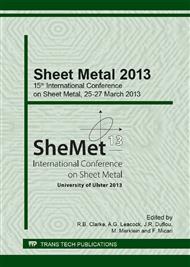[1]
T. Young: Journal of Aerospace Engineering, published online (2012)
Google Scholar
[2]
R. D. Joslin: Annu. Rev. Fluid Mech., Vol. 30, (1998) p.1–29
Google Scholar
[3]
D. M. Bushnell: Journal of Aerospace Engineering, Vol. 217, No. 1, pp.1-18
Google Scholar
[4]
R. Chilukuri: U.S. Patent 6,354,538 Bl (2002)
Google Scholar
[5]
M. Sanchez, A. K. Kundu, B. K. Hinds and S. Raghunathan: Int J Adv Manuf Technol, Vol. 14 (1998), pp.894-900
Google Scholar
[6]
R. Curran, K. Kundu, S. Raghunathan and R. McFadden: Journal of Aerospace Engineering, Vol. 216 p.29 – 39
Google Scholar
[7]
H. Riedel, K.-H. Horstmann, A. Ronzheimer and M. Sitzmann: Aerospace Science and Technology, Vol. 2, No. 1, (1998), pp.1-12
Google Scholar
[8]
G. K. Faust and P. Mungur: In NASA, Langley Research Center, Research in Natural Laminar Flow and Laminar-Flow Control, Part 3 pp.891-907 (SEE N90-12539 04-02), (1987)
Google Scholar
[9]
Y. Lin, S. Raghunathan, B. Raghunathan and S. McIlwain: Journal of Aerospace Engineering, Vol. 226 (2012), p.42 – 54.
Google Scholar
[10]
J. R. Stewart: Patent Application No. WO 2012/071339 A1 (2012).
Google Scholar
[11]
R. T. White, T. J. Liebig and J. K. Switzer: U.S. Patent 5,035,133 (1991).
Google Scholar
[12]
L. Chevalier: U.S. Patent 6,866,223 B2 (2005).
Google Scholar
[13]
P. Kulkarni and P. Shashikiran: U.S. Patent 7,334,447 B1 (2008).
Google Scholar
[14]
J. R. Stewart: U.S. Patent US 7,340,933 B2 (2008)
Google Scholar
[15]
D. G. Sanders, M. Ramulu and P. D. Edwards: Materialwissenschaft und Werkstofftechnik, Vol. 39, No. 4-5, (2008) pp.353-357.
Google Scholar
[16]
R. G. Kendall and D. A. Burford: U.S. Patent 6,955,283 B2 (2005)
Google Scholar
[17]
D. G. Sanders, D. W. Foutch, J. D. Will, L. Leon, G. L. Ramsey and G. A. Booker: U.S. Patent Application US2011/0256343 A1 (2011)
Google Scholar
[18]
Information on http://www.flightglobal.com/news/articles/boeing-envisions-third-parallel-line-for-737-max-366763/, (Accessed on November 2012)
Google Scholar
[19]
Information on http://www.aviationweek.com/Article.aspx?id=/article- xml/avd_05_25_2012_p03-01-461788.xml, (Accessed on November 2012)
Google Scholar
[20]
A. G. Leacock, M. Ludlow, D. Brown and R. J. McMurray: European Patent 2 328 698 B1 (2009).
Google Scholar


